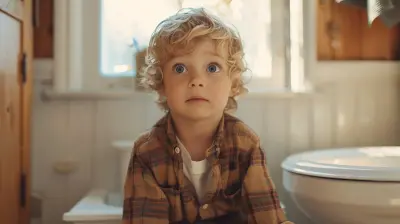Involving Older Siblings in Childproofing the Home
24 November 2025
Parenting is a team effort, right? Sure, you’ve got the baby monitor, the outlet covers, and the baby gates all set up. But there’s one secret weapon you might be overlooking: your older kids. Yep, we’re talking about involving older siblings in childproofing the home. It’s not just helpful—it can be a game changer. Let’s dig into how bringing them into the process makes things safer, smoother, and honestly, kind of heartwarming.
Why Get Older Siblings Involved in Childproofing?
So, why bother? Can’t adults handle it? Of course, we can, but here’s the thing—older siblings are your in-house surveillance team. They see things we don’t. They know what their younger sibling is up to because, chances are, they’ve been there before.Plus, when children feel responsible, even in small ways, they rise to the occasion. Giving them a role in keeping their younger brother or sister safe builds their confidence. It also tightens the family bond, making everyone feel like part of the same mission: keep the little tornado (aka the baby) safe.
The Benefits of Involving Older Siblings
1. They Learn Responsibility Early
Responsibility isn’t something you can shove down a kid’s throat. But when you give them a real task, like making sure the baby doesn’t chew on remote controls, it doesn’t just teach accountability—it makes them feel important. It’s like giving them their own superhero badge.2. It Strengthens the Sibling Bond
Helping with baby-proofing makes older siblings feel more connected to their younger siblings. It shifts the narrative from “the baby’s getting all the attention” to “I’m helping to raise this tiny human.” They feel proud, and pride makes love grow.3. It Keeps Safety in Real-Time Check
Even with the most meticulous childproofing, you can’t be everywhere all the time. Big siblings can act as an extra pair of eyes. Got a baby climbing the couch? Big bro might spot it before you do. Baby chewing on shoes? Big sis knows that’s not a snack.
What Age is ‘Older Enough’ to Help?
Let’s be real—you can’t expect a toddler to understand the intricacies of choking hazards. But kids around 5 years and up can start playing a role. The older they are, the more they can handle. Just match responsibilities to their maturity level.Think of it like leveling up in a game:
- Ages 5-7: Spot hazards, alert adults, keep doors closed that should stay closed.
- Ages 8-10: Help clean up small toys, lead by example, explain rules to younger siblings.
- Ages 11+: Assist in actual childproofing tasks like installing cabinet locks or organizing safety zones.
How to Introduce the Idea Without Making It a Chore
Getting kids on board takes finesse. If you say, “You need to help baby-proof the living room,” expect groans. Instead, frame it as a mission.Try THIS:
“Hey, we’re forming a Super Safety Squad to protect your little brother. Want to be a part of it?”
Genius, right?
Turn tasks into games. Give them code names. Create weekly “missions." Giving the task a playful touch makes it way more appealing.
Smart Ways Older Siblings Can Help With Childproofing
Alright, let’s talk action. Here are some real, practical ways older siblings can step into their new role as junior safety officers.1. Keeping Floors Clear of Small Objects
When you’ve got LEGO lovers in the house, small pieces are everywhere. Babies see them as snacks. Older siblings can keep floors tidy and make a game of “baby item sweep.” A quick once-over before bedtime or before playtime helps a ton.2. Locking and Securing Hazard Zones
Big kids can help make sure doors to unsafe places (bathrooms, kitchen cabinets, your bedroom with all the sharp adult stuff) stay locked. Teach them how to check that cabinet locks are in place before letting the baby crawl around.3. Identifying Risky Behavior
They’re often the first to see what the baby can now reach. Like when baby suddenly grows an inch and can grab the TV remote—older siblings will notice that shift before we do. Ask for regular “risk reports” from your junior team member.4. Being a Role Model
Kids mimic everything. An older sibling who puts away their toys after playing, closes doors gently, and avoids using electronics around the baby sets an amazing example.5. Creating Safe Play Zones
Invite older kids to help lay out a safe area for the baby. Let them pick out soft toys, select a few books, and cordon off dangerous items. Make it their “baby protection zone.”Teaching Safety Without Stressing Them Out
You don’t want your older kid to feel like the baby’s babysitter. That’s not the goal. This is about teamwork.Here’s how to strike that balance:
- Talk about “Team Family.” Everyone has a role, and no one’s job is more important than the other.
- Set clear limits. “If you see something unsafe, come find me—don’t try to fix it alone.”
- Celebrate wins. “Hey, thanks for pointing out the bottle of cleaner on the counter earlier. That was a big help!”
When Older Siblings Might Push Back
Not gonna lie—some older siblings might roll their eyes at the idea of helping “for the baby again.” That’s normal. They might be feeling jealous, overwhelmed, or just bored with baby stuff.So, what do you do?
- Acknowledge their feelings. “I know it’s not super exciting, but your help means a lot.”
- Give them choices. “Would you rather help check for choking hazards or keep the baby from climbing the stairs?”
- Include rewards. Could be stickers, extra screen time, or just a special shoutout during family dinner.
Keeping It Age-Appropriate and Fun
The golden rule? Don’t dump too much on them. Keep it light. Keep it age-appropriate. And keep it fun. Most kids actually like being helpful—as long as they feel appreciated and not overburdened.Try these ideas:
- Create a “Safety Captain” badge for the week.
- Have them draw a baby-safe toy map.
- Do a treasure hunt around the house: “Find 5 things the baby shouldn’t touch!”
Involving Them in the Actual Childproofing Setup
Got an older kid who’s a little more hands-on? Let them help install those outlet covers and drawer locks. Teach them what makes something dangerous. Walk through the house together and identify hot spots.Grab a checklist, turn it into a scavenger hunt, and go room-to-room. Make them feel like your second-in-command. Trust me—they’ll love the responsibility, and you’ll love the extra help.
What About Teens?
Oh, teens. They’re in their own world, right? But you’d be surprised—many of them are incredibly protective of younger siblings. Tap into that sense of responsibility they already have (even if they’d never admit it out loud).Let them handle:
- Checking tech dangers—phones, chargers, headphones left on the floor.
- Keeping an eye on social boundaries: not letting the baby crawl into the bathroom or near stairs.
- Teaching the baby safe ways to play with toys or interact with pets.
And hey—recognize their help. A simple, “I really appreciate you watching your brother while I made lunch,” goes miles.
The Big Picture: Building a Safer, Kinder Home
Here’s the deal: Childproofing isn’t just about locks and latches. It’s about raising a village. When you involve older siblings in keeping your home safe, you’re doing more than just preventing accidents. You’re teaching empathy, teamwork, and long-term responsibility.You’re giving your kids a front-row seat to what it means to look out for others. And let’s be real—those are the kinds of lessons that stick.
Wrapping It Up: Your New Sidekick Has Arrived
Parenting is tough. You need all the help you can get, and sometimes that help is already walking around your house—eating cereal, building forts, and probably asking to stay up late.Involving older siblings in childproofing the home isn’t just a smart move—it’s a beautiful bonding opportunity. Safety becomes a family affair. And honestly? That’s kind of magical.
So go ahead and recruit your little helpers. Make them feel important, appreciated, and trusted. Because building a safe, loving home? That’s a mission worth sharing.
all images in this post were generated using AI tools
Category:
ChildproofingAuthor:

Max Shaffer

